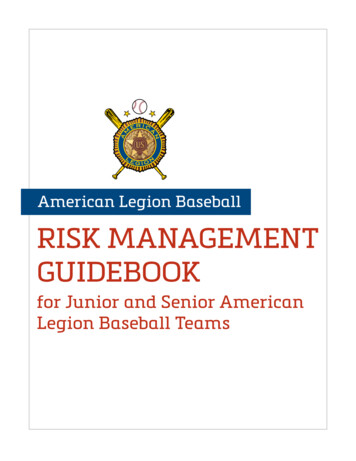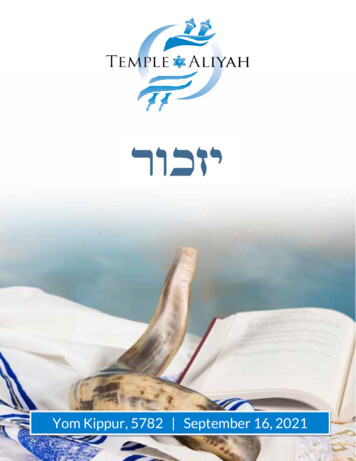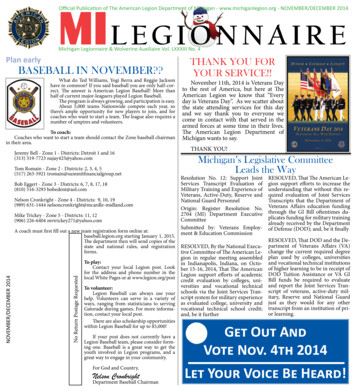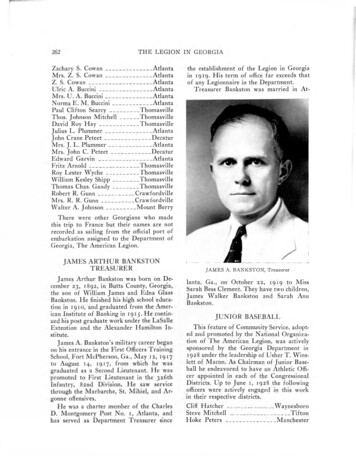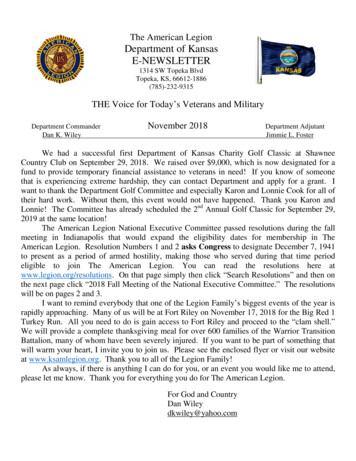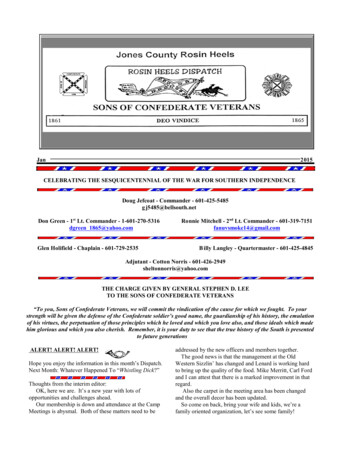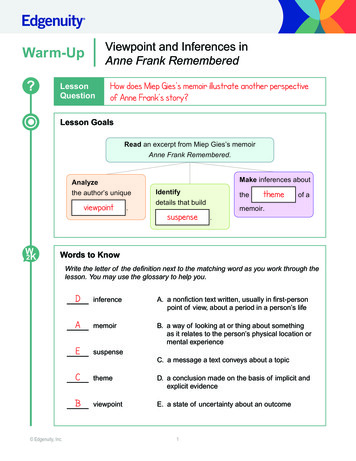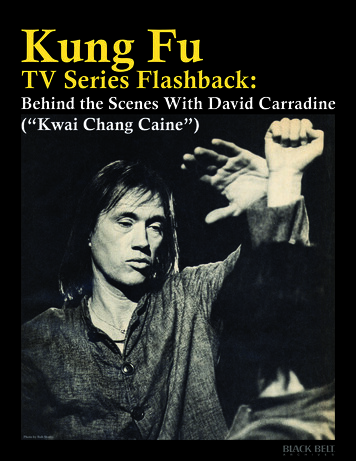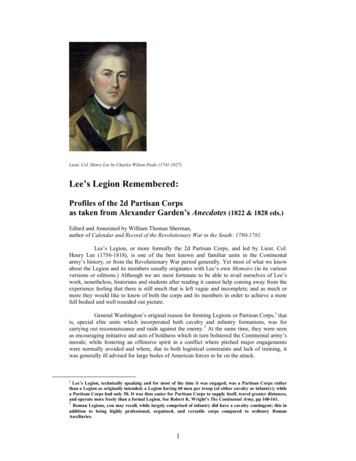
Transcription
Lieut. Col. Henry Lee by Charles Wilson Peale (1741-1827)Lee’s Legion Remembered:Profiles of the 2d Partisan Corpsas taken from Alexander Garden’s Anecdotes (1822 & 1828 eds.)Edited and Annotated by William Thomas Sherman,author of Calendar and Record of the Revolutionary War in the South: 1780-1781.Lee’s Legion, or more formally the 2d Partisan Corps, and led by Lieut. Col.Henry Lee (1756-1818), is one of the best known and familiar units in the Continentalarmy’s history, or from the Revolutionary War period generally. Yet most of what we knowabout the Legion and its members usually originates with Lee’s own Memoirs (in its variousversions or editions.) Although we are most fortunate to be able to avail ourselves of Lee’swork, nonetheless, historians and students after reading it cannot help coming away from theexperience feeling that there is still much that is left vague and incomplete; and as much ormore they would like to know of both the corps and its members in order to achieve a morefull bodied and well rounded out picture.General Washington’s original reason for forming Legions or Partisan Corps,1 thatis, special elite units which incorporated both cavalry and infantry formations, was forcarrying out reconnaissance and raids against the enemy.2 At the same time, they were seenas encouraging initiative and acts of boldness which in turn bolstered the Continental army’smorale; while fostering an offensive spirit in a conflict where pitched major engagementswere normally avoided and where, due to both logistical constraints and lack of training, itwas generally ill advised for large bodes of American forces to be on the attack.1Lee’s Legion, technically speaking and for most of the time it was engaged, was a Partisan Corps ratherthan a Legion as originally intended; a Legion having 60 men per troop (of either cavalry or infantry); whilea Partisan Corps had only 50. It was thus easier for Partisan Corps to supply itself, travel greater distances,and operate more freely than a formal Legion. See Robert K. Wright’s The Continental Army, pp 160-161.2Roman Legions, you may recall, while largely comprised of infantry did have a cavalry contingent; this inaddition to being highly professional, organized, and versatile corps compared to ordinary RomanAuxiliaries.1
Henry Lee’s Light Dragoons was initially formed at Williamsburg, Virginia onJune 8, 1776 as the 5th Troop of Light Horse of the Virginia State Troops. Later in earlysummer of that same year it was entered into the Continental Army; and by late Novemberwas assigned to the Main Army and incorporated into the 1st Continental Light Dragoons,under Col. Theodoric Bland.3 Lee’s troop received the special notice and approbation ofWashington in late January 1778 when they thwarted a surprise attack by numericallysuperior British forces at the Spread Eagle Tavern, in Philadelphia.4On 7 April 1778, the contingent was separated from the 1st Continental LightDragoons; and Lee was promoted to Major and authorized by Congress, at GeneralWashington’s request, to augment his unit from one to two troops with a mind to forming aLegion or independent corps.5 In May, this was further increased to three troops and a3For this and subsequent information on the Legion’s organizational history see Fred Anderson Berg’sContinental Army Units, pp. 60-61, and Robert K. Wright’s The Continental Army, pp. 161-162, 348-349.4Cecil B. Hartley: “As Captain Lee was particularly active, a plan was formed, late in January [1778], tosurprise and capture him in his quarters. An extensive circuit was made by a large body of cavalry, whoseized four of his patrols without communicating an alarm. About break of day the British horse appeared ;upon which Captain Lee placed his troopers that were in the house, at the doors and windows, who behavedso gallantly as to repulse the assailants without losing a horse or man. Only Lieutenant [William] Lindsay andone private were wounded. The whole number in the house did not exceed ten. [Hartley’s note –‘Major[John] Jameson was accidentally present, and engaged in this skirmish.’] That of the assailants was said toamount to two hundred. They lost a sergeant and three men, with several horses, killed; and an officer andthree men wounded.“The following is Captain Lee's report of this affair to General Washington: ‘I am to inform your Excellencyof an action, which happened this morning, between a party of the enemy's dragoons and my troop of horse.They were near two hundred in number, and by a very circuitous route endeavored to surprise me inquarters. About daybreak they appeared. We were immediately alarmed, and manned the doors andwindows. The contest was very warm ; the British dragoons trusting to their vast superiority in number,attempted to force their way into the house. In this they were baffled by the bravery of. my men. After havingleft two killed and four wounded, they desisted and sheered off. We are trying to intercept them. ColonelStevens has pushed a party of infantry to reach their rear. So well directed was the opposition, that we drovethem from the stables and saved every horse. We have got the arms, some cloaks, &c. of their wounded. Theonly damage I at present know of, is a slight wound received by Lieutenant Lindsay. I am apprehensive aboutthe patrols. The enterprise was certainly daring, though the issue of it very ignominious. I had not a soldierfor each window.’-- January 20th.“Again: ‘We have at length ascertained the real loss of this day. Four privates, belonging to the patrol at thesquare, were taken. I am told they made a brave resistance. The quartermaster-sergeant, who imprudentlyran from our quarters prior to the commencement of the skirmish, was also taken. The loss sustained standsthus : one sergeant and four privates taken; one lieutenant and two privates wounded. By what I can learnfrom the people of Derby, the enemy's loss is as follows : three privates dead ; one commissioned officer, onesergeant, and three privates wounded.’“The following letter of General Washington to Captain Lee attests his sense of the merit of his youngprotégé: ‘ My Dear Lee, Although I have given you my thanks in the general orders of this day, for the lateinstance of your gallant behavior, I cannot resist the inclination I feel to repeat them again in this manner. Ineeded no fresh proofs of your merit, to bear you in remembrance. I waited only for the proper time andseason to show it ; those, I hope, are not far off. I shall also think of and will reward the merit of Lindsay,when an opening presents, as far as I can consistently; and I shall not forget the corporal, whom you haverecommended to my notice. Offer my sincere thanks to the whole of your gallant party, and assure them, thatno one felt pleasure more sensibly, or rejoiced more sincerely for your and their escape, than youraffectionate, &c." -- Hartley, Life of Maj. Gen. Henry Lee, pp. 32-34; see as well Marshall, Life of Washington,Vol. III, p. 377.5Washington's letter to the President of Congress soliciting Lee's promotion to Major: “Captain Lee of thelight dragoons, and the officers under his command, having uniformly distinguished themselves by a conductof exemplary zeal, prudence, and bravery, I took occasion, on a late signal instance of it, to express the highsense I entertained of their merit, and to assure him, that it should not fail of being properly noticed. I wasinduced to give this assurance from a conviction, that it is the wish of Congress to give every encouragementto merit, and that they would cheerfully embrace so favorable an opportunity of manifesting this disposition.I had it in contemplation at the time, in case no other method more eligible could be adopted, to make him anoffer of a place in my family. I have consulted the committee of Congress upon the subject, and we weremutually of opinion, that giving Captain Lee the command of two troops of horse on the proposedestablishment, with the rank of major, to act as an independent partisan corps, would be a mode ofrewarding him very advantageous to the service. Captain Lee's genius particularly adapts him to a commandof this nature; and it will be the most agreeable to him of any station in which he could be placed.“I beg leave to recommend this measure to Congress, and shall be obliged by their decision as speedily as maybe convenient. The campaign is fast approaching, and there will probably be very little time to raise and2
quartermaster added; though one of these acted as a dismounted formation. The including offoot soldiers with the cavalry was seen as measure necessary to insure the flexibility andsurvivability of the unit. Then in July, Captain Allan McLane’s Delaware infantry companywas assigned as a fourth troop; so that by the end of August the corps had 200 men; withsoldiers from not only Virginia and Delaware, but Maryland, New Jersey, Pennsylvania andConnecticut as well. It achieved particular notoriety, including an acknowledgment of thanksby Congress, for its participation in a daring and mostly successful night raid on the Britishoutpost of Paulus Hook, New Jersey in August 1779.6On 14 February 1780, Lee was granted authorization to form a formal LegionaryCorps; and many of the best soldiers from other units either volunteered or were speciallyinvited to join its ranks. When the issue of the utility of Legionary and Partisan corps to thearmy was raised by Congress, Washington in a letter of 11 October 1780 addressed to thePresident and in response to them stated: “In general I dislike independent corps, I think apartisan corps with an army useful in many respects. Its name and destination stimulate toenterprise; and the two officers I have mentioned have the best claims to public attention.Colonel [Charles] Armand is an officer of great merit, which, added to his being a foreigner,to his rank in life, and to the sacrifices of property he has made, renders it a point of delicacyas well as justice to continue to him the means of serving honorably. Major Lee has renderedsuch distinguished services, possesses so many talents for commanding a corps of thisnature, and deserves so much credit for the perfection in which he has kept his corps, as wellas for the handsome exploits he has performed, that it would be a loss to the service, and adiscouragement to merit, to reduce him, and I do not see how he can be introduced into oneof the regiments in a manner satisfactory to himself, and which will enable him to be equallyuseful, without giving too much disgust to the whole line of cavalry.”By 1 November 17807 Lee’s force was increased in size to three mounted andthere dismounted; and at about which same time it was detached from the Main Army andsent to reinforce the Southern Army badly mauled at the battle of Camden, 16 August 1780.On 1 January 1781, the Legion was re-designated the 2d Partisan Corps, and when it joinedGeneral Greene by early January numbered some 100 cavalry and 180 foot which wereorganized as into three troops of horse under Captains Joseph Eggleston, Ferdinand O’Neal,and James Armstrong, and 3 companies of infantry led by Captains Patrick Carnes, MichaelRudulph and George Handy. Among it marks of distinction, the “Legion” was one of the bestclothed and equipped units in the Continental Army; this due in no small part to Lee’sdogged and persistent determination to make it so. At least his mounted legionnaires woregreen jackets because on several occasions they were mistaken for men of both Simcoe’sQueen’s Rangers8 and Tarleton’s British Legion (and or else members of those two unitswere mistook for Lee’s men); while Lee himself, in his Memoirs, speaks of his cavalrywearing “green coatees and leather breeches.” Yet this is about as much information as wehave to go on and apparently applies only to the cavalry;9 otherwise supply records intimateprepare the corps for it. It is a part of the plan to give Mr. Lindsay the command of the second troop, and tomake Mr. Peyton captain-lieutenant of the first." Cecil B. Hartley’s The Life of Major General Henry Lee, pp85-86.6Although Capt. Allan McLane (1746-1829) played decisive roles in both Stony Point, N.Y., and Paulus Hook(with the former being the inspiration for the latter undertaking), he was unjustly neglected when the honorsfor both these victories were handed out, and this no doubt contributed to his falling out with Lee (whom hedid not subsequently get along well with), and his leaving the corps to be re-assigned to a separate duty inJan. 1781. For an account of McLane’s war services and amazing adventures, see Garden, vol. 2, pp. 76-83,and American Heritage Magazine, Oct. 1956, vol. 7, Issue 6; available at /ah/1956/6/1956 6 74.shtml7Lee himself was promoted to Lieutenant Colonel on 6 November 1780.8Lee, Memoirs, pp. 301n-302n.9However, there is a most intriguing cavalry figure -- dark green coated with white collar and facings;wearing a smaller version of the British Legion style helmet, and with tan vest and breeches -- in AlonzoChappel’s (1828-1887) painting “Washington’s Farewell to His Officers, 1783” (c. 1857) that may very well bethe uniform in question. While it is true Chappel did do a painting (now lost but that survives as an engraving)specifically of the Legion cavalry at Guilford Court House, it is uncertain whether it was done before or after3
that at least some of the unit were attired in blue coats with red trim and white linen. Forheadgear, leather caps were most frequently used by Continental cavalrymen; however someare known to have worn visored black or brown leather helmets; with felt hats making anoccasional appearance.10While in the south serving under Greene the Legion occasionally took in recruitsfrom local Carolinians; some of whom became notable in its service. Also, in May of 1781,some 25 North Carolina Continentals under Maj. Pinkertham Eaton were added to the ranksof the Legion Infantry; in part, apparently, to offer them temporary training; as well as tostrengthen the Legion’s numbers.By early 1782, Lee removed himself from command and returned north. Then inJune, Greene divided the Legion by combining its cavalry with detachments from the 3rd and4th Continental Light Dragoons, under Col. George Baylor;11 and then by assigning theinfantry of the Legion to Lieut. Col. John Laurens’ Light Infantry battalion. The reaction onthe part of the Legion was one of dismay and indignation, and all resigned in protest. Greene,however, was able to somewhat appease and console them; those who would not stay weregranted furlough to return north.12 The unit finally and formally disbanded at Winchester,Virginia on 15 November 1783.“Washington’s Farewell.” In the “Legion at Guilford,” the troopers wear a metal helmet very similar to theone worn by Thomas Young Seymour of the Connecticut Light Dragoons in the portrait by John Trumbull(1756-1843), but with shell covered in black rather than brass or gold; surmounted by a metal crest on whichhanging horse hair is attached; with, as well, as metal visor broader than Seymour’s. The green jackets are cutat the waists, and have relatively high collars and long cuffs, and which latter, as depicted in some colorings ofthe engraving, are buff-yellow. It is not impossible that both the dragoons shown in “Washington’s Farewell”and or “Guilford” are accurate representations of how the unit appeared at different times. It was trying tokeep any regiment in the Continental army properly outfitted in the field. And with Lee’s Legion being one ofthe optimally clothed compared to other American units, they doubtless still had to make shift attiringthemselves as best they could and as changing circumstances allowed; so that the result was still, at least inmany instances in the course of several campaigns, something of an amalgam. The Legion infantry itself hasbeen spoken of as being at one time in purple trousers and purple jackets when in the north (Don Troiani’sSoldier’s of the American Revolution, by Troiani and Kochan, pp. 156-160), and then there are records ofscarlet and blue cloth being issued to them while in the south (Uniforms of the Continental Army by PhilipKatcher, pp. 39-40) -- as well as the painting of Laurence Manning of the infantry; where he wears aconventional blue army coat with red collars and facing, and silver epaulette.Also the Legion, like other British and American legions, was inspired and styled itself in precedent onSimcoe’s Queen’s Rangers, who were very careful and strict about their uniforms, yet loved a little flourishand extra adornment for color; for example, in the crescent moon worn on their headgear, and, on oneoccasion, when they put on white and black feathers in mourning for André (Simcoe, p. 152; Simcoe also,incidentally, commends Lee’s Legion for its discipline, p. 136.) Since lack of regular equipment preventedstrict uniformity of the Legion’s clothing, a concomitant harmony of élan, spirit, and swagger (such as, say,Garden implies) not only permitted but encouraged divers clothing and gear to be used in a creative andcolorful manner; providing at least they had good to better aesthetic taste; which it is probably safe toconclude the majority of legion officers and men had. That Lee prided himself on the unit's look andappearance, including their gentlemanly deportment (as, for instance, in the quasi-for its time knightlytreatment of Brown and the King's Rangers at and after the fall of Augusta) added to Garden’s dashingpicture of the legion, would seem to strongly support such a surmise.10See Lee, Memoirs of the War in the Southern Department of the United States (1869 ed.) p. 302n., PhillipKatcher’s Uniforms of the Continental Army, pp. 36, 39-40.11With respect to the 3d and 4th Continental Light Dragoons see Berg, p. 30-31.12Lee, Memoirs, pp. 550-553.4
Portrait of Lieutenant Laurence Manning, of the Legion Infantry;by John Trumbull (1756-1843), Yale University Art Gallery.Part I.But for Alexander Garden (1757-1829), son of noted Scotch-American physician,botanist -- and Loyalist -- of the same name (1730-1792), our knowledge and idea of theofficers and men under Lee’s command would be a great deal more shadowy and sketchythan it is. Born in Charleston, S.C., Garden for most of the war was in Scotland pursuingstudies at the University of Glasgow. Nonetheless, in July 1780 he returned to British heldCharleston, and sometime, but apparently not earlier than after the battle of Eutaw Springs in8 September 1781, he somehow managed to join up with and enlist in Greene’s army; beingfirst made a Cornet in Lee’s Legion; rising to Lieutenant by February 1782; and for a period(presumably due to his cultured and well educated background) acted as aide-de-camp toGeneral Greene. After the war, his father’s estate, that would otherwise have beenconfiscated, was awarded to him by the state of South Carolina. He later published twoseparate volumes of Revolutionary War Anecdotes, viz.:* Anecdotes of the Revolutionary War in America: With Sketches of Character ofPersons the Most Distinguished, in the Southern States, for Civil and Military Services A.E.Miller, Charleston, 1822.* Anecdotes of the American Revolution: Illustrative of the Talents and Virtues ofthe Heroes of the Revolution, Who Acted the Most Conspicuous Parts Therein.-- Second Series. A.E. Miller, Charleston, 1828.These “anecdotes,” although largely second or third hand in origin, were oftenenough taken from original participants themselves whom he knew personally; not least ofwhich, for our purposes, his old comrades and fellow officers in Lee’s Legion.Although sometimes unabashedly patriotic even to the point at times of beingsuspect in their accuracy, and despite how other portions of his text merely re-relate DavidRamsay, William Moultrie, or other early Revolutionary War historian (including Garden’sformer commander, Henry Lee), Garden’s accounts often contain much rare, candid, andunusual information not found elsewhere and to that extent are much more credible than wemight, initially and on the surface, otherwise expect of them.5
What follows here then are reminiscences of some of the officers, noncommissioned officers and enlisted men of Lee’s corps. These profiles and vignettes makeup only a portion, though a substantial portion, of the Anecdotes as a whole; and for thatreason might be easily overlooked or bypassed by those not specifically researching Lee’sLegion. What we get is a very lively more detailed picture of the men; certainly as good orbetter as any we find elsewhere in the literature of that very early time of chronicling theRevolution; and which succeeds well both at imparting the spirit of loyalty and comraderythat characterized the corps; providing records of their individual bravery and virtues; as wellas filling in important, and occasionally amusing, dramatic, or touching, details we simplyhave no other means of knowing about. At the same time, this gathering of informationaffords the opportunity to fill some of the gaps in the record further by way of footnote andannotation; which we have striven to do here. Although many facts are still unknown andoriginal materials sometimes scarce if not non-existent, I hope we, with Garden’s mostunique and gifted assistance, will have at least managed to get significantly closer to ourobject of better appreciating and understanding what the Legion was, and who the men werewho filled its ranks or led therein. *** Excerpts from Anecdotes of the Revolutionary War in America: With Sketches of Characterof Persons the Most Distinguished, in the Southern States, for Civil and Military ServicesA.E. Miller, Charleston, 1822. By Alexander Garden, of Lee’s Partisan Legion; Aid-DeCamp to Major General Greene; And Honorary Member of the Historical Society of NewYork. [Beginning at p. 123.]Character and Conduct of Officers of the Legion * I feel too proud of the partial friendship experienced from my brother Officers ofthe Legion, not to be ambitious, in some degree, to acquit myself of my debt of gratitude, byrecording the successes resulting from their exemplary good conduct, and the achievementsthat gave many of them, peculiar claims to celebrity. Where merited praise is not bestowed, Ican truly aver, that it will not proceed from intentional neglect. The title of most of them todistinction, has been repeatedly acknowledged by their general, and confirmed by theflattering concurrence of their confederates in arms. I can only speak particularly of thosewith whom I was most familiar, and best acquainted. Major John Rudolph [Rudulph], theCaptains [Henry] Archer and Hurd, the facetious Captain Carns [Patrick Carnes], bold inaction, in quarters the delight of his associates; George Carrington, [William] Winston,[Jonathan] Snowden, [James] Lovell, [Robert] Power, [William Butler] Harrison, Lumford[Swanson Lunsford], and [John] Jordan, performed every duty with alacrity, and with thehighest advantage to the service.6
Captain Joseph Eggleston13Cavalry.This meritorious Officer was endowed with superior powers of mind, butdecidedly better qualified to gain celebrity in the cabinet, than in the field. He had the mostperfect knowledge of duty, and was ever prompt in its performance; but the spirit ofenterprise particularly requisite in a Partisan, was foreign to his nature. There occurred,however, one recontre [sic] with the enemy, in which he acquired distinction, both for [p.123] talent and intrepidity. On the retreat of the British army from Ninety-Six, Lee, knowingthat the rich settlement South of Fridig’s [also “Friday’s”] ferry, could alone afford theforage which they would require, determined to avail himself of the probable chance ofstriking a blow, which should paralyze every future movement, Eggleston was detached forthe purpose, to the expected scene of action, and choosing an advantageous position,anxiously awaited their approach. A party of sixty British dragoons, and some foragingwagons speedily appeared, evidently intending to reach the very farm he occupied. Thelegionary cavalry rushed forward with irresistible impetuosity, the enemy were at once put torout, the wagons taken, and forty-five dragoons brought off prisoners, without the loss of asingle man.14It is painful to state, though the imputations of blame rest not on him, that theopportunity of totally destroying the British cavalry at Eutaw was lost, by his having, fromhis ardour to perform his duty, obeyed an unauthorized order to engage. Foiled, andcompelled to retire, when summoned to advance by Lee, he was too far distant to supportArmstrong, who was ready to engage, but unequal with a single troop to meet the superiorforce of [John] Coffin.15 On the day following the battle, however, he rendered very essentialservice, charging the retiring enemy, and taking from them several wagons containing storesand baggage. On this occasion, his horse was killed under him – he himself escaping withoutinjury, though five balls pierced his clothes and equipments.At the conclusion of the war, turning his attention to literary pursuits, he wasreturned a Member of Congress, in which respectable body he obtained applause anddistinction. [p. 124]Of warm and impatient temper, while yet in the flower of his age, tormented bythe irritation of a disordered leg, and insisting on amputation, mortification ensued, whichcaused his immediate and untimely dissolution.13Eggleston (1754-1811), a William and Mary graduate and originally part of Lee’s first troop of VirginiaState Cavalry, served with distinction in the Legion throughout the war and was afterward, among othernumerous public offices he held, a U.S. Representative from the state of Virginia from 1798 to 1801. Hisgravesite is located in the Old Grubhill Church Cemetery, near Amelia Court House in Amelia County,Virginia.143 July 1781, Lee, Memoirs, p. 381.15Regarding both Eutaw Springs, 8 September 1781, and the lost opportunity to defeat Coffin and turn theBritish left flank, see Lee, Memoirs, pp. 463-475, Gibbes’ Documentary History Vol. 3 p. 151, and Papers ofNathaniel Greene, Vol. IX (Dennis Conrad, editor) pp. 335n-336n.7
Captain James Armstrong16Cavalry.There was no Officer in the service of the United States, whose feats of daring,had made a more salutary impression on the minds of the enemy, than those of Armstrong ofthe Legion. The British did justice to his merits; they admired his valor; they gratefullyacknowledged his humanity; and when he, by an accident, became their prisoner, behavedtowards him with marked and flattering attention. Had they displayed the same generousconduct towards others, which they exercised towards him, the asperities of the war wouldhave been softened, and nothing heard of those acts of intemperate violence, which debasedtheir characters as men.The details of his achievements are to be met with in every history of the war; itwould be superfluous again to repeat them. But, one instance of his attention to a brave andunfortunate Soldier, has not, in my judgment been sufficiently dwelt upon. LieutenantColonel Lee was certainly a man of strong prejudices; but, where admiration was excitedtowards a gallant enemy, his generosity was unbounded. Fascinated by the consummate skilland bravery of Colonel Browne [loyalist, Thomas Brown], in the defense of his post atAugusta, his resolution was immediately fixed, to save him from the fury of an exasperatedpopulation, and the better to effect it, [p. 125] put him under the safeguard of Armstrong, toconduct him to Savannah. The precaution was the more necessary, as the inveteracy of party,in the neighbourhood of Augusta, had given birth to a war of extermination, and he saw thatwithout such interposition a gallant Soldier, who had committed himself to his enemy, ontheir plighted faith, would otherwise have been sacrificed. Colonel [James] Grierson of theBritish militia, had already fallen by an unknown hand; and to have risked a repetition of thecrime, w
Lee's Legion Remembered: Profiles of the 2d Partisan Corps as taken from Alexander Garden's Anecdotes (1822 & 1828 eds.) Edited and Annotated by William Thomas Sherman, author of Calendar and Record of the Revolutionary War in the South: 1780-1781. Lee's Legion, or more formally the 2d Partisan Corps, and led by Lieut. Col.
